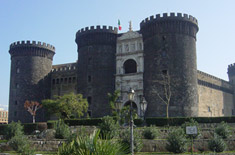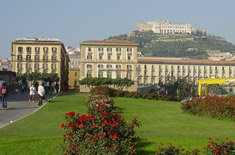Naples
People often ask me what I think one of the most beautiful cities in Europe is. I’d have to say Naples, Italy because it’s bellisima! Welcome to one of the most fascinating cities in Italy! You know, to describe Naples, would be to say it’s indulgent, sensual, it’s noisy, definitely exciting and without a doubt, crazy!
Roman mythology says when one of the Sirens died, she created the city of Napoli, and her passion remains today. Here, they enjoy every moment! Now, is it because Mount Vesuvius is still an active volcano….or do they just love life? Once the largest city in Europe, Naples has an incredible location at the base of Mt. Vesuvius and it is certainly is full of activity. The song, “Funiculi Funicula,” was written about the two funiculars that will take you up the side of a hill for an amazing view of the sea.
Like an enormous amphitheater rising up the hillsides, with mandatory low buildings providing everyone an unobstructed view, Naples is truly one of the most beautiful cities in Europe. Like all European coastal cities, life grew up around the sea, and the Bay of Naples must be one swell neighborhood to grow up in! Everyone looks to the water as cruise ships, fishing boats and sailboats vie for docking space, as well as your attention, in an ever-changing landscape of color and charm. The gentle rocking of these sleeping boats makes you forget how important the water is to Naples’ economy!
A popular port of call for big cruise lines, the Port of Naples brings tourists here, well, by the boat-load! All ashore who’s going ashore for the vacation of a lifetime! Fishing remains a big industry for enterprising Neopolitans, and a lazy pastime for others. Watersports are popular with some of the younger generation, while others prefer just kicking back and admiring the view. And what a view it is…

Two castles on the waterfront are a reminder that Naples was once a walled and fortified city, occupied at one time by Greeks, Romans and Normans, among others! Standing on the islet of Megaris, Castel dell ’Ovo is the oldest castle in Naples. Once the headquarters of the Royal Treasury and a Royal Residence, it’s name means “castle of the egg” and it’s origin is a bit mysterious. Although the castle was built according to an oval or egg-shaped plan, legend links its name to the wizard Vergil and a magic egg he supposedly kept hidden somewhere behind the walls.
The castle has “eggselent” views of the sea and the city, and definitely worth a quick “scramble” through!. Oooo…couldn’t resist!
Nearby, the 13th century Castel Nuovo, or “new castle,” was so named to distinguish it from Castello dell’Ovo, which was eventually inadequate as a royal residence. Over the years, fires, wars and sieges destroyed the original castle. The castle we see today was rebuilt in 1443 under the rule of Alfonso the Magnanimous and reflected a more modern system of defense.
The Arch of Triumph of Alfonso is the most notable ornament of the palace and is an important monument in the history of 15th Century art in southern Italy. Check out the Torre dell’Oro. It’s a different color than the other towers because it’s the only tower that shows its volcanic stone structure without decorative stones covering it up! The castle was modernized once again in 1939 when the 16th century fortifications were removed and replaced with avenues and flower beds.
A third castle rounds out the trio of castles in Naples. The star-shaped Castel Saint Elmo was originally built to help defend the city as it crowned the ring of enclosure walls. Sadly, it was used more against the City of Naples than to defend it, and served as a prison for centuries. A tourist attraction today, it’s known for its panoramic views of the city and the gulf. So, would that be with or without bars on the windows? These and other ancient fortifications act as reminders of Naples’ legacy as a military city.
 Piazza Bellini is not only a popular place for lunch, it’s also the spot where you can see the 2500 year old Greek wall that surrounded the city. It was so impenetrable, the Romans couldn’t conquer it, they had to negotiate their way in. Just think. Amazing…Back then, Naples was protected by water…and this wall!”
Piazza Bellini is not only a popular place for lunch, it’s also the spot where you can see the 2500 year old Greek wall that surrounded the city. It was so impenetrable, the Romans couldn’t conquer it, they had to negotiate their way in. Just think. Amazing…Back then, Naples was protected by water…and this wall!”
As you gaze across the skyline of Naples, the Neopolitan integrity, determination and artistic pride is evident in the buildings and homes that make up this enchanting seaside city. Beautiful, yet sturdy, the architecture reflects the charming feistiness the natives of Naples have become famous for! And with an endless supply of volcanic sandstone to work with, the artists and artisans of Naples have erected beautiful monuments, fountains and statues everywhere you look!
While there’s so much to see and explore here in Naples, what you see from street level is only the half of it! I just found out that Naples is twice as exciting as I thought. I didn’t know that the other half was underground. A hundred feet down. Beneath the streets of Naples, is a whole other city, a “Parallel City” as many call it. Dating from the Greco-Roman periods, a honeycomb of inter-connected tunnels, caverns, aqueducts, and passages were created when volcanic sandstone was excavated to build the city’s palaces and villas.
Carved from legend, this is the “sotto-suolo” or underground of Naples. As the city was built above ground, they took the stone from underground. So what does one do with a massive cave under your house? Well, way back when, some of the empty caverns were put to use as water cisterns and later, air raid shelters. In all, some 700 cavities have been discovered so far. Greek caves, Roman and Bourbon tunnels, catacombs and natural grottos, make up a total of over 600 square miles of what they call the “underground city.” These rooms are huge. They used to be filled with water, in fact, you can still see the water line. These tunnels are endless – you could get lost down here. That’s why you only go underground with a guide or a group.
There are tours depicting the tunnels as air raid shelters. There is an exhibition about things that were found down here when it was refuge during the war. The helmets, gas masks, dishes, and things from the soldiers are all here to give you an image how it looked when there were about 2000 people down here in the system when the bombs were falling.
The entire underground city was created by Greek and Roman slaves when they mined these caves for building materials. Grueling work, lit only by candlelight, many of them died in the process. On the tour, you’ll see a public cistern that is much older than the air raid refuge. Who knew plumbing could be so cool!? This underground tour is so cool! I had no idea that you could do something like this here. A little adventure….a little history….this is a great discovery! If you come to Naples and don’t see the underground city, you are really missing something special. It is incredible!”
I’ll tell you what else is incredible, there’s still another discovery to see down here. But you have to enter from a secret place up top into a very small residence, typical of the peasant homes of the area. In this flat or apartment a man lived for many years, and in making repairs, he discovered the ancient Greek and Roman Theatre under the foundation. This was in the 1950’s, and the man made an entrance to it that he hid under his bed. He was afraid he would be put out of his home due to it being a monumental archaeological find, so he kept the theater and the entrance secret. There’s so much more to see…no one knows exactly how much remains to be discovered. Ongoing explorations indicate that possibly, another 1200 square miles of unexplored, undocumented spaces and evolving history are yet to be found.

Speaking of Naples’ history, did I mention Naples as being at the base of Mt. Vesuvius, the one that erupted and covered Pompeii? The volcano Vesuvius? Oh yes…And what remains of Pompeii is right down the road, one place you definitely have to see while you’re here! Pompeii is probably the most impressive archaeological site in the world. Now is it touristy? Yes, it is, but you have to look at it like you’re looking through a screen door. You’ve got to look through all the touristy stuff and once you see what’s on the inside it’s worth it. It’s amazing how well-preserved some of these ruins are. For a city that was completely destroyed by a volcanic eruption, it still looks pretty good!
How crowded was it? Nobody really knows how many people lived in Pompeii during its heyday – that remains a hot topic of debate. They estimate 18,000 people lived here during the eruption. But what’s interesting, is that they think maybe twice that amount lived here before that, because 17 years earlier there was an earthquake and a lot people left. Unbelievable! Once you visit Pompeii, or any architectural site for that matter, it’s an experience you’d like to stay with you for at least a little while. That’s why souvenir stands are staked out at the exit, so you can take a little bit of Pompeii home with you for later! You know, a souvenir is not necessarily a bad thing. But, memories do come at a price, so be prepared to do a little bargaining! And check out ALL the vendors before you buy! Ready…set…shop!
I think it’s time to go back to the city, so hop on the subway and head on back to town. Getting around Naples couldn’t be easier, public transportation is convenient, clean and affordable! This gives you a chance to check out some of the neighborhoods! And what better place to start than in the Latin Quarter? One of the most colorful and crowded parts of town, the Latin Quarter is not only a great place to live, it’s the best place to buy the freshest baked goods, produce and seafood… lots of seafood! You could also just hang out and soak up some local color! Or, do like the Neopolitans do and tool around on a moped all day! Vroom! Vroom!
The smaller street markets can be fun, too, you never know what you’re going to find! The most famous market in town is the market of nativity scenes. Here, getting ready for Christmas is a year round activity! San Gregorio Armanio, named for the San Gregorio Church, and this is the Armenian old craft section. This is where you will find the Nativities, and you won’t believe the detail in these handcrafted treasures. Whether simple or elaborate, these nativity scenes have several things in common. They always have a cork bottom, the crèche always goes on top and you have representations of food on the right and village life on the left. Every family here puts up a nativity scene in their house. Iit can be little and simple, or it can be big and grand and ornate and expensive…but here in Naples, making the nativity scene is an art!
Famous all over the world, these crèches or “presepio” as they’re known here, are all handmade, each piece different, and the best craftsmen are still found working in their ancestral family workshops. Their skill and talent are overshadowed only by the commitment to this craft and dedication to the subject matter. Trust me…if you decide that just have to take one of these crèches home with you, it will be a family keepsake for years!
You know Naples is known for pizza and piazzas. You eat one, you’re gonna walk it off on the other. And speaking of walking, bring rubber sole shoes; you wear leather soles and… whoops! You end up right on your bottom. Those cobblestones are wicked!” And speaking of walking, spend some time walking around Piazza del Plebiscito. Originally built for local ceremonies and festivals, it’s still pretty festive today, and you never know what you’re going to see! Built right in the center of the city, the Piazza del Plebiscito is the site of the Royal Palace, the Oldest Theatre in Naples and the Galleria Umberto that is loved so much! “Ah Naples! Everywhere you look, a photo. It’s a bellisimo!”

After a day of sightseeing there’s nothing like going home to a hotel that’s not just a hotel….but a truly unusual discovery. I discovered a jewel, a treasure if you will, that’s very new, yet so full of incredible history, I almost hate to share it! It’s called the Hotel San Francesco al Monte Convento…I love saying that! “San Francesco Al Monte Convento!” Basically it means a convent, or monastery. Simply, this was the home to Franciscan monks for over 400 years!
Restored as a 4 star hotel, I say it’s unusual because, while you’re spoiled in total comfort, you can still see much of what the monastery was like in the 16th century! It’s like being in caves and caverns carved into the mountainside! And the views are spectacular from every place and room in the hotel.
You’ll see what life was like in the old days of Naples, with the reverence of the monks and the service they brought to the populous. You’ll want to explore the entire structure and don’t forget to check out the gardens and grotto pool at the top. Well worth it for the relaxation and the expansive views.
Naples…what a Positively Perfect Place! Known for piazzas, “Presepio,” Pompeii! And you know what else? The invention of the pizza! Now that’s special! Naples is where pizza was invented. So, where do the Neopolitans go to get the best pizza? I asked around and everybody I talk to agreed – Trianon. It’s off the beaten path, it’s been making pizzas since 1923, but everybody says it’s the best. It’s a little hole in the wall, but you just have to see how a good pizza is done!
They have a a special recipe. The special pizza that they do has 8 or 9 different sections, mozzarella on one, prosciotto on one…It’s gorgeous, it’s a work of art, it should be in a museum. Legend has it that in the late 1800s, King Umberto and his consort, Queen Margherita were touring Naples. An Italian baker named Raffaele Esposito, wanted to impress them, and to show his patriotic fervor, he chose to top flat bread with food that would best represent the colors of Italy: red tomato, white mozzarella cheese and green basil. The king and queen were so impressed that word quickly reached the masses. I wonder if they offered free delivery!
Great food, good wine, beautiful scenery and wonderful people. Naples is a city that’s expressive and vibrant. From the harbor, to the surrounding countryside, Naples is a breathtaking destination that will always know the volatile prescence of Vesuvious.
You know what I love about Italy? Is that every city here has its own character and its own style and Naples is definitely a city unto itself. Nobody’s telling it where to go or what to do. Like it’s people, it’s sometimes passionate…, sometimes passive, but with a stability that’s based on old-fashioned traditions that celebrate its ancient culture and a love of life. Napoli, bellisima!
